Unit 9 lớp 10: Preserving The Environment - Communication and Culture
Bài học Unit 9 lớp 10 mới phần Communication and Culture giúp các em có thêm các kiến thức văn hóa xã hội với chủ đề của "Preserving The Environment". Qua đó các em được củng cố từ vựng và ngữ pháp đã học.
Mục lục nội dung
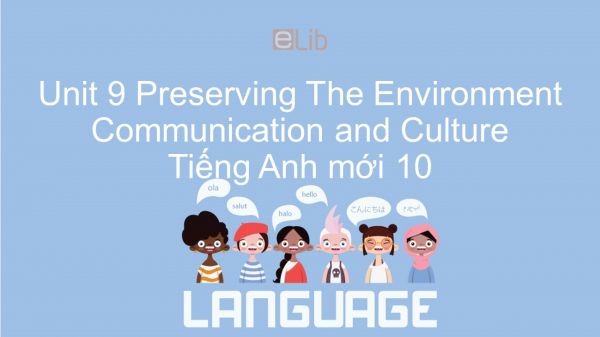
Unit 9 lớp 10: Preserving The Environment - Communication and Culture
1. Communication
Discussion (Thảo luận)
1.1. Task 1 Unit 9 lớp 10
Work in pairs. (Làm theo cặp.)
a. Label the photos. (Gọi tên hình.)
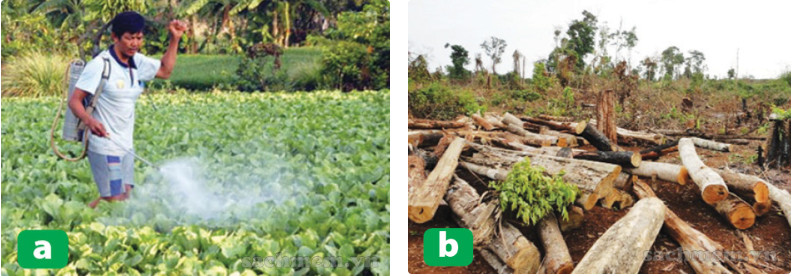
Guide to answer
a. Photo a: A man is spraying pesticides. (Hình a: Một người đàn ông đang phun thuốc trừ sâu. )
Photo b: Forest trees were cut down. (Hình b: Cây trong rừng bị chặt.)
b. Describe what you see in each photo: state the environmental problems and their effects. (Miêu tả những gì em thấy trong mỗi bức hình, nêu ra những vấn đề môi trường và hiệu ứng của nó.)
Guide to answer
- Photo a: A man is spraying pesticides. This can cause soil pollution.
(Hình a: Một người đàn ông đang phun thuốc trừ sâu. Điều này gây ô nhiễm đất.)
- Photo b: Forest trees were cut down. This is deforestation and it will result in climate change, global warming, extreme floods and erosion.
(Hình b: Cây trong rừng bị đốn hạ. Đây là phá rừng và nó sẽ dẫn đến biến đổi khí hậu, sự nóng dần lên toàn cầu, lũ lụt nghiêm trọng và xói mòn đất.)
1.2. Task 2 Unit 9 lớp 10
Listen to the recording. Ask and answer the following questions. (Nghe bài nghe. Hỏi và trả lời những câu hỏi sau.)
Click to listen
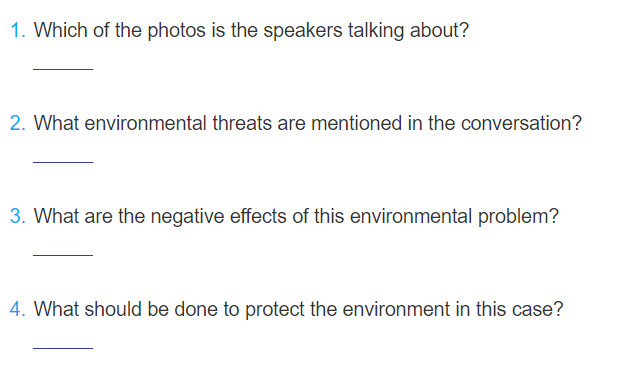
Guide to answer
1. Photo b.
2. Deforestation.
3. Climate change, global warming, and extreme floods.
4. Control deforestation and have proper forestation plans.
Tạm dịch:
1. Những hình ảnh nào là người nói đang nói đến?
=> Hình b.
2. Những tổn hại môi trường mà được đề cập trong bài đàm thoại?
=> Phá rừng.
3. Những ảnh hưởng tiêu cực của vân đề môi trường?
=> Biến đổi khí hậu, sự nóng dần lên toàn cầu, lủ lụt nghiêm trọng.
4. Điều gì nên được làm để bảo vệ mồi trường trong trường hợp này?
=> Kiểm soát việc phát quang rừng ưà có kế hoạch trồng rừng hợp lý.
Audio Script:
A: What can you see in this photo?
B: Forest trees are being cut down.
A: What do you call this environmental threat.
B: Well, it is deforestation.
A: What are the effects of deforestation?
B: It can lead to a series of environmental problems such as climate change, global warming, and extreme floods.
A: What should we do to prevent deforestation?
B: We should control deforestation and have appropriate forestation plans to replace the trees cut down.
Tạm dịch
A: Bạn có thể thấy gì trong bức ảnh này?
B: Cây rừng đang bị chặt hạ.
A: Điều gì làm bạn gọi đây là mối đe dọa môi trường.
B: Vâng, đó là phá rừng.
A: Tác động của phá rừng là những gì ?
B: Nó có thể dẫn đến một loạt các vấn đề môi trường như biến đổi khí hậu, nóng lên toàn cầu và lũ lụt cực đoan.
A: Chúng ta nên làm gì để ngăn chặn nạn phá rừng?
B: Chúng ta nên kiểm soát phá rừng và có kế hoạch trồng rừng thích hợp để thay thế cây bị chặt hạ.
1.3. Task 3 Unit 9 lớp 10
Discuss in groups. Suggest what should be done to protect the environment. (Thảo luận theo nhóm. Đề nghị điều gì nên được làm để bảo vệ môi trường.)
Guide to answer
We should save water and electricity for long term use. We shouldn't throw rubbish everywhere. We also should use public transportation or bicycle more often. We need to plant more trees in our places.
Tạm dịch:
Chúng ta nên tiết kiệm nước và điện để sử dụng lâu dài. Chúng ta không nên ném rác khắp nơi. Chúng ta cũng nên sử dụng phương tiện công cộng hoặc xe đạp thường xuyên hơn. Chúng ta cần trồng cây nhiều hơn ở nơi chúng ta ở.
2. Culture
2.1. Task 1 Unit 9 lớp 10
Look at the logo. Can you recognize the animal? Where does it come from? What does the abbreviation WWF mean? Quickly read the text to check your answers. (Nhìn vào logo, em có thể nhận ra động vật gì không? Nó đến từ đâu? Chữ viết tắt WWF có nghĩa là gì? Đọc nhanh và kiểm tra câu trả lời của em.)
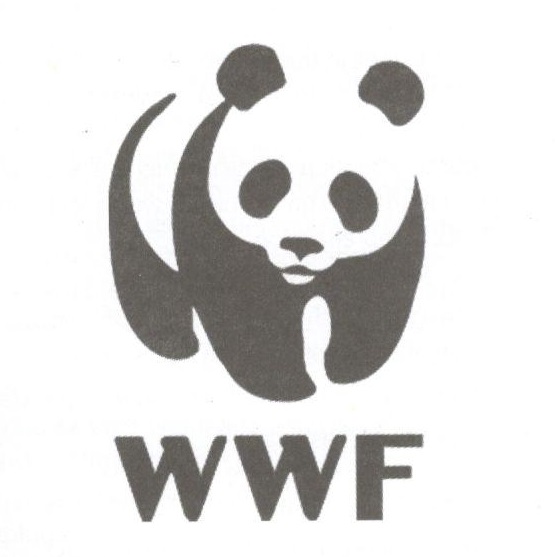
Guide to answer
A panda. It comes from China. WWF stands for World Wide Fund for Nature (formly for World Widelife Fund)
(Một con gấu trúc. Nó đến từ Trung Quốc. WWF viết tắt của Quỹ bảo vệ thiên nhiên quốc tế, (trước đây là World Wildlife Fund)
2.2. Task 2 Unit 9 lớp 10
Read the text again. Ask and answer the questions. (Đọc lại đoạn văn. Hỏi và trả lời các câu hỏi sau.)
The World Wide Fund for Nature (WWF), originally called The World Wildlife Fund, is a non-government organisation. It was set up in 1961, and had its operations in areas such as the preservation of biological diversity, sustainable use of natural resources, the reduction of pollution, and climate change.
The symbol of WWF originates from a panda named Chi Chi, which was transferred from the Beijing zoo to the London zoo in 1961 when the organisation was established. Chi Chi was the only giant panda in the Western world at that time and one of the most endangered animals. WWF recognized it as the symbol of the organisation.
In 1986, the organisation changed its name to World Wide Fund for Nature to better reflect its activities. However, it has operated under the original name in the United States and Canada. In the 1990s, WWF revised its mission to: ‘Stop the degradation of the planet’s natural environment and build a future in which humans live in harmony with nature, by:
- conserving the world’s biological diversity
- ensuring that the use of renewable natural resources is sustainable
- promoting the reduction of pollution and wasteful consumption.’
WWF is the world’s largest independent conservation organisation with over 5 million supporters worldwide, working in more than 100 countries, supporting around 1,300 conservation and environmental projects.
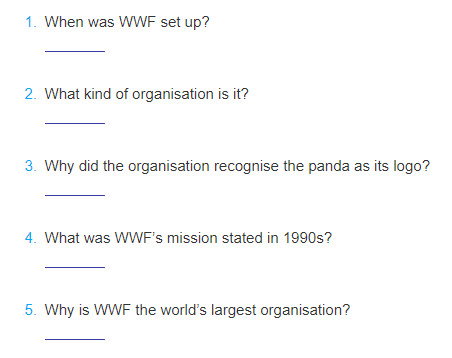
Guide to answer
1. In 1961.
2. A non-government organisation.
3. Because it was the only giant panda, an endangered species, in the Western world at the same time as the organization is established.
4. "Stop the degradation of the planet’s natural environment and build a future in which humans live in harmony with nature, by:
- conserving the world’s biological diversity
- ensuring that the use of renewable natural resources is sustainable
- promoting the reduction of pollution and wasteful consumption"
5. It is the world’s largest independent conservation organisation.
Tạm dịch:
Quỹ Quốc tế Bảo vệ Thiên nhiên (WWF), ban đầu được gọi là Quỹ Quốc tế Động vật Hoang dã, là một tổ chức phi chính phủ. Nó được thành lập vào năm 1961 và đã hoạt động ở những lĩnh vực như bảo tồn sự đa dạng sinh học, sử dụng lâu bền tài nguyên thiên nhiên, giảm ô nhiễm và biến đổi khí hậu.
Biểu tượng của WWF xuất phát từ một con gấu trúc tên là Chi Chi, mà được chuyển từ vườn thú Bắc Kinh sang vườn thú Luân Đôn vào năm 1961 khi tổ chức được thành lập. Chi Chi là con gấu trúc lớn duy nhất ở thế giới phương Tây lúc đó và là một trong những động vật có nguy cơ tuyệt chủng nhất. WWF đã nhận nó là biểu tượng của tổ chức.
Vào năm 1986, tổ chức đã thay đổi tên thành World Wide Fund for Nature (Quỹ Quốc tế Bảo vệ Thiên nhiên) để có phản ánh tốt hơn những hoạt động của nó. Tuy nhiên, nó đã hoạt động dưới tên gốc ở Mỹ và Canada. Vào những năm 1990, WWF đã sửa lại sứ mạng của nó: “Ngừng việc bào mòn môi trường tự nhiên của trái đất và xây dựng một tương lai mà trong đó con người sống hòa hợp với thiên nhiên, bằng cách: bảo tồn đa dạng sinh học thế giới, đảm bảo rằng việc sử dụng những nguồn tài nguyên thiên nhiên có thể làm mới là bền vững, tăng cường giảm ô nhiễm và tiêu thụ lãng phí.
WWF là tổ chức bảo tồn độc lập lớn nhất thế giới với hơn 5 triệu người ủng hộ trên khắp thế giới, làm việc ở hơn 100 quốc gia, hỗ trợ khoảng 1.300 dự án môi trường và bảo tồn.
1. Quỹ quốc tế bảo vệ thiên nhiên được thành lập khi nào?
Năm 1961.
2. Nó là loại tổ chức gì?
Tổ chức phi chính phủ.
3. Tại sao tổ chức lại nhận gấu trúc làm logo của nó?
Bởi vì nó là chú gấu trúc khổng lồ duy nhất, một loài đang bị đe dọa, ở thế giới phương Tây cùng lúc tổ chức này được thành lập.
4. Sứ mạng của Quỹ Quốc tế Bảo vệ Thiên nhiên là gì vào những năm 1990?
"Ngừng việc làm ô nhiễm môi trường tự nhiên của trái đất và xây dựng một tương lai mà trong đó con người sống hài hòa với thiên nhiên, bằng cách:
- bảo tồn sự đa dạng sinh học của thế giới
- đảm bảo rằng việc sử dụng những nguồn tài nguyên có thể làm mới là bền vững
- tăng cường việc giảm ô nhiễm và tiêu thụ lãng phí”.
5. Tại sao Quỹ Quốc Tế bảo vệ thiên nhiên là tổ chức lớn nhất thế giới?
Nó là tổ chức bảo tồn độc lập lớn nhất thế giới.
3. Practice Task 1
Choose the letter A, B, C or D the word that has the underlined part different from others.
Question 1: A. organic B. protect C. solution D. editor
Question 2: A. fuel B. destruction C. bulky D. running
Question 3: A. confuse B. debut C. pollution D. fuel
Question 4: A. chemical B. change C. discharge D. choose
4. Practice Task 2
Rewrite sentences without changing the meaning
Question 1: “I am sorry but I won’t do the extra work,” Carol said.
A. Carol promise not to do the extra work.
B. Carol denied doing the extra work.
C. Carol refused to do the extra work.
D. Carol apologised for doing the extra work.
Question 2: He prefers siting at home to playing outside.
A. He would ather sit at home than play outside.
B. He hates both siting at home and playing outside.
C. He plays outside more often than he sits at home.
D. He sometimes plays outside instead of siting at home.
Question 3: “Go home.” said the teacher to us.
A. The teacher told us to go home
B. The teacher said us to go home
C. The teacher told us go home
D. The teacher told to us to go home
Question 4: He won the first prize thanks to his good reaction.
A. He won the first prize though he didn’t react well.
B. He thanked his good reaction after he had won the first prize.
C. He wouldn’t have won the first prize withought his good reaction.
D. He reacted well because he won the first prize.
Question 5: “Don’t forget to clean your teeth,” said Granny to Helen.
A. Granny told Helen not forget to clean her teeth.
B. Granny remind Helen to clean her teeth.
C. Granny told Helen to not forget to clean her teeth.
D. Granny said Helen not to forget to clean her teeth.
Để nắm các từ vựng và các điểm ngữ pháp giúp quá trình giao tiếp diễn ra thuận lợi, mời các em đến với phần luyện tập trắc nghiệm Unit 9 Communication and Culture Tiếng Anh 10 mới sau đây.
6. Conclusion
Kết thúc bài học, các em làm bài tập đầy đủ, thảo luận về các việc nên làm để bảo vệ môi trường và đọc bài để hiểu về Quỹ bảo vệ thiên nhiên quốc tế.
Tham khảo thêm
- doc Unit 9 lớp 10: Preserving The Environment - Getting Started
- doc Unit 9 lớp 10: Preserving The Environment - Language
- doc Unit 9 lớp 10: Preserving The Environment - Reading
- doc Unit 9 lớp 10: Preserving The Environment - Speaking
- doc Unit 9 lớp 10: Preserving The Environment - Listening
- doc Unit 9 lớp 10: Preserving The Environment - Writing
- doc Unit 9 lớp 10: Preserving The Environment - Looking Back
- doc Unit 9 lớp 10: Preserving The Environment - Project




